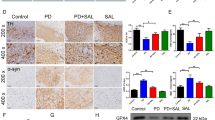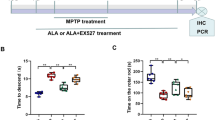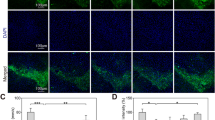Abstract
Parkinson’s disease (PD) is a neurodegenerative disorder closely associated with oxidative stress. The biochemical and cellular alterations that occur after cell and mouse treatment with the parkinsonism-inducing neurotoxin MPP+/MPTP are remarkably similar to those observed in idiopathic PD. Previously, we showed that ferulic acid (FA) has antioxidant properties and the ability to activate nuclear factor E2–related factor 2 (Nrf2). The present study tested the hypothesis that FA attenuates MPP+/MPTP-induced oxidative stress by regulating crosstalk between sirtuin 2 (SIRT2) and Nrf2 pathways. To test this hypothesis, we performed in vitro and in vivo studies using MPP+/MPTP-challenged SH-SY5Y cells or mice treated with or not with FA. FA marginally inhibited SIRT2 in parallel with α-synuclein at levels of transcription and translation in SH-SY5Y cells challenged with MPP+. Moreover, FA attenuated MPP+-induced oxidative stress, as indicated by reactive oxygen species, lipid hydroperoxides, GSH/GSSG ratio, and NAD+/NADH ratio. Mechanistically, FA strongly upregulated the glutamate cysteine ligase catalytic subunit and heme oxygenase-1 expression at the levels of transcription and translation. Interestingly, FA-mediated extracellular signal–regulated kinases 1 and 2 (ERK1/2) activation contributed to nuclear accumulation of Nrf2 via de novo synthesis, which was validated by the use of dominant negative ERK2. Surprisingly, activation of the ERK1/2 and inhibition of SIRT2 by FA are mediated by independent mechanisms. Furthermore, FA ameliorated motor deficits and oxidative stress in the ventral midbrain in MPTP-treated (25 mg/kg, i.p., daily for 5 days) wild-type mice and α-synuclein knockout mice, but not in Nrf2 knockout mice. Collectively, FA exerts antioxidant effects through ERK1/2-mediated activation of the Nrf2 pathway, and these results may have important translational value for the treatment of PD.







Similar content being viewed by others
Abbreviations
- ARE:
-
Antioxidant response element
- DCFH-DA:
-
2′,7′-Dichlorofluorescein-diacetate
- DN:
-
Dominant negative
- ERK:
-
Extracellular signal–regulated kinases
- FA:
-
Ferulic acid
- GCL:
-
Glutamate cysteine ligase
- GSH:
-
Glutathione
- HO-1:
-
Heme oxygenase-1
- KO:
-
Knockout
- LPO:
-
Lipid hydroperoxides
- MAPK:
-
Mitogen-activated protein kinase
- MDA:
-
Malondialdehyde
- MPP+ :
-
1-Methyl-4-phenylpyridinium
- MPTP:
-
1-Methyl-4-phenyl-1,2,3,6-tetrahydropyridine
- NADH:
-
Nicotinamide adenine dinucleotide
- NQO1:
-
NAD(P) H quinone oxidoreductase 1
- Nrf2:
-
Nuclear factor E2-related factor 2
- PD:
-
Parkinson’s disease
- ROS:
-
Reactive oxygen species
- shRNA:
-
Short hairpin RNA
- SIRT2:
-
Sirtuin 2
- Trx1:
-
Thioredoxin 1
- WT:
-
Wild-type
References
Szökő É, Tábi T, Riederer P, Vécsei L, Magyar K (2018) Pharmacological aspects of the neuroprotective effects of irreversible MAO-B inhibitors, selegiline and rasagiline, in Parkinson’s disease. J Neural Transm (Vienna) 125:1735–1749
Ganguly U, Chakrabarti SS, Kaur U, Mukherjee A, Chakrabarti S (2018) Alpha-synuclein, Proteotoxicity and Parkinson’s disease: search for neuroprotective therapy. Curr Neuropharmacol 16:1086–1097
Liss B, Striessnig J (2019) The potential of L-type calcium channels as a drug target for neuroprotective therapy in Parkinson’s disease. Annu Rev Pharmacol Toxicol 59:263–289
Lang AE, Melamed E, Poewe W, Rascol O (2013) Trial designs used to study neuroprotective therapy in Parkinson’s disease. Mov Disord 28:86–95
Zhang PL, Chen Y, Zhang CH, Wang YX, Fernandez-Funez P (2018) Genetics of Parkinson's disease and related disorders. J Med Genet 55:73–80
Sharma N, Rao SP, Kalivendi SV (2019) The deglycase activity of DJ-1 mitigates α-synuclein glycation and aggregation in dopaminergic cells: role of oxidative stress mediated downregulation of DJ-1 in Parkinson's disease. Free Radic Biol Med 135:28–37
Choi JH, Jang M, Nah SY, Oh S, Cho IH (2018) Multitarget effects of Korean red ginseng in animal model of Parkinson’s disease: antiapoptosis, antioxidant, antiinflammation, and maintenance of blood-brain barrier integrity. J Ginseng Res 42:379–388
De Lazzari F, Bubacco L, Whitworth AJ, Bisaglia M (2018) Superoxide radical dismutation as new therapeutic strategy in Parkinson’s disease. Aging Dis 9:716–778
Negida A, Menshawy A, El Ashal G, Elfouly Y, Hani Y, Hegazy Y, El Ghonimy S, Fouda S et al (2016) Coenzyme Q10 for patients with Parkinson's disease: a systematic review and meta-analysis. CNS Neurol Disord Drug Targets 15:45–53
Nicoletti G, Crescibene L, Scornaienchi M, Bastone L, Bagalà A, Napoli ID, Caracciolo M, Quattrone A (2001) Plasma levels of vitamin E in Parkinson’s disease. Arch Gerontol Geriatr 33:7–12
Wang Y, Cai Y, Huang H, Chen X, Chen X, Chen X, Mai H, Li X et al (2018) miR-486-3p influences the neurotoxicity of a-synuclein by targeting the SIRT2 gene and the polymorphisms at target sites contributing to Parkinson’s disease. Cell Physiol Biochem 51:2732–2745
Outeiro TF, Kontopoulos E, Altmann SM, Kufareva I, Strathearn KE, Amore AM, Volk CB, Maxwell MM et al (2007) Sirtuin 2 inhibitors rescue alpha-synuclein-mediated toxicity in models of Parkinson’s disease. Science 317:516–519
Di Fruscia P, Zacharioudakis E, Liu C, Moniot S, Laohasinnarong S, Khongkow M, Harrison IF, Koltsida K et al (2015) The discovery of a highly selective 5,6,7,8-tetrahydrobenzo[4,5]thieno[2,3-d]pyrimidin-4(3H)-one SIRT2 inhibitor that is neuroprotective in an in vitro Parkinson’s disease model. ChemMedChem 10:69–82
Liu L, Arun A, Ellis L, Peritore C, Donmez G (2012) Sirtuin 2 (SIRT2) enhances 1-methyl-4-phenyl-1,2,3,6-tetrahydropyridine (MPTP)-induced nigrostriatal damage via deacetylating forkhead box O3a (Foxo3a) and activating Bim protein. J Biol Chem 287:32307–32311
Yang X, Park SH, Chang HC, Shapiro JS, Vassilopoulos A, Sawicki KT, Chen C, Shang M et al (2017) Sirtuin 2 regulates cellular iron homeostasis via deacetylation of transcription factor NRF2. J Clin Invest 127:1505–1516
Bresciani A, Missineo A, Gallo M, Cerretani M, Fezzardi P, Tomei L, Cicero DO, Altamura S et al (2017) Nuclear factor (erythroid-derived 2)-like 2 (NRF2) drug discovery: biochemical toolbox to develop NRF2 activators by reversible binding of Kelch-like ECH-associated protein 1 (KEAP1). Arch Biochem Biophys 631:31–41
Choi JW, Kim S, Park JH, Kim HJ, Shin SJ, Kim JW, Woo SY, Lee C et al (2019) Optimization of vinyl sulfone derivatives as potent nuclear factor erythroid 2-related factor 2 (Nrf2) activators for Parkinson’s disease therapy. J Med Chem 62:811–830
Xu X, Song N, Wang R, Jiang H, Xie J (2016) Preferential heme oxygenase-1 activation in striatal astrocytes antagonizes dopaminergic neuron degeneration in MPTP-intoxicated mice. Mol Neurobiol 53:5056–5065
Park JS, Leem YH, Park JE, Kim DY, Kim HS (2019) Neuroprotective effect of β-lapachone in MPTP-induced Parkinson’s disease mouse model: involvement of Astroglial p-AMPK/Nrf2/HO-1 signaling pathways. Biomol Ther (Seoul) 27:178–184
Shah MA, Bosco SJ, Mir SA (2014) Plant extracts as natural antioxidants in meat and meat products. Meat Sci 98:21–33
Leonti M, Stafford GI, Cero MD, Cabras S, Castellanos ME, Casu L, Weckerle CS (2017) Reverse ethnopharmacology and drug discovery. J Ethnopharmacol 198:417–431
Bolognesi ML (2017) Neurodegenerative drug discovery: building on the past, looking to the future. Future Med Chem 9:707–709
Huang C, Wu J, Chen D, Jin J, Wu Y, Chen Z (2019) Effects of sulforaphane in the central nervous system. Eur J Pharmacol 853:153–168
Yu CL, Zhao XM, Niu YC (2016) Ferulic acid protects against lead acetate-induced inhibition of neurite outgrowth by upregulating HO-1 in PC12 cells: Involvement of ERK1/2-Nrf2 pathway. Mol Neurobiol 53:6489–6500
Raju A, Jaisankar P, Borah A, Mohanakumar KP (2018) 1-Methyl-4-phenylpyridinium-induced death of differentiated SH-SY5Y neurons is potentiated by cholesterol. Ann Neurosci 24:243–251
Jost MM, Budde P, Tammen H, Hess R, Kellmann M, Schulte I, Rose H (2005) The concept of functional peptidomics for the discovery of bioactive peptides in cell culture models. Comb Chem High Throughput Screen 8:767–773
Patel VP, Chu CT (2014) Decreased SIRT2 activity leads to altered microtubule dynamics in oxidatively-stressed neuronal cells: implications for Parkinson's disease. Exp Neurol 257:170–181
Guedes A, Ludovico P, Sampaio-Marques B (2017) Caloric restriction alleviates alpha-synuclein toxicity in aged yeast cells by controlling the opposite roles of Tor1 and Sir2 on autophagy. Mech Ageing Dev 161:270–276
Sarrafchi A, Bahmani M, Shirzad H, Rafieian-Kopaei M (2016) Oxidative stress and Parkinson’s disease: new hopes in treatment with herbal antioxidants. Curr Pharm Des 22:238–246
Li C, Tang B, Feng Y, Tang F, Pui-Man Hoi M, Su Z, Ming-Yuen Lee S (2018) Pinostrobin exerts neuroprotective actions in neurotoxin-induced Parkinson’s disease models through Nrf2 induction. J Agric Food Chem 66:8307–8318
Zhou X, Zhang Y, Shen Y, Zhang X, Xu S, Shang Z, Xia M, Wang M (2019) Efficient production of androstenedione by repeated batch fermentation in waste cooking oil media through regulating NAD+/NADH ratio and strengthening cell vitality of Mycobacterium neoaurum. Bioresour Technol 279:209–217
Silva-Islas CA, Maldonado PD (2018) Canonical and non-canonical mechanisms of Nrf2 activation. Pharmacol Res 134:92–99
Wang J, Huang X, Zhang K, Mao X, Ding X, Zeng Q, Bai S, Xuan Y et al (2017) Vanadate oxidative and apoptotic effects are mediated by the MAPK-Nrf2 pathway in layer oviduct magnum epithelial cells. Metallomics 9:1562–1575
Lalith Kumar V, Muralidhara (2014) Ameliorative effects of ferulic acid against lead acetate-induced oxidative stress, mitochondrial dysfunctions and toxicity in prepubertal rat brain. Neurochem Res 39:2501–2515
Guo JD, Zhao X, Li Y, Li GR, Liu XL (2018) Damage to dopaminergic neurons by oxidative stress in Parkinson’s disease (review). Int J Mol Med 41:1817–1825
Chandra G, Shenoi RA, Anand R, Rajamma U, Mohanakumar KP (2019) Reinforcing mitochondrial functions in aging brain: an insight into Parkinson’s disease therapeutics. J Chem Neuroanat 95:29–42
Snow BJ, Rolfe FL, Lockhart MM, Frampton CM, O’Sullivan JD, Fung V, Smith RA, Murphy MP et al (2010) A double-blind, placebo-controlled study to assess the mitochondria-targeted antioxidant MitoQ as a disease-modifying therapy in Parkinson’s disease. Mov Disord 25:1670–1674
Zduńska K, Dana A, Kolodziejczak A, Rotsztejn H (2018) Antioxidant properties of ferulic acid and its possible application. Skin Pharmacol Physiol 31:332–336
Mujalli A, Chicanne G, Bertrand-Michel J, Viars F, Stephens L, Hawkins P, Viaud J, Gaits-Iacovoni F et al (2018) Profiling of phosphoinositide molecular species in human and mouse platelets identifies new species increasing following stimulation. Biochim Biophys Acta Mol Cell Biol Lipids 1863:1121–1131
Ojha S, Javed H, Azimullah S, Abul Khair SB, Haque ME (2015) Neuroprotective potential of ferulic acid in the rotenone model of Parkinson’s disease. Drug Des Devel Ther 9:5499–5510
Fariss MW, Zhang JG (2003) Vitamin E therapy in Parkinson’s disease. Toxicology 189:129–146
Ding H, Wang X, Wang H, Zhu L, Wang Q, Jia Y, Wei W, Zhou C et al (2017) Nrf2-ARE signaling provides neuroprotection in traumatic brain injury via modulation of the ubiquitin proteasome system. Neurochem Int 111:32–44
Wang X, Guan Q, Wang M, Yang L, Bai J, Yan Z, Zhang Y, Liu Z (2015) Aging-related rotenone-induced neurochemical and behavioral deficits: role of SIRT2 and redox imbalance, and neuroprotection by AK-7. Drug Des Devel Ther 9:2553–2563
Pan Y, Zhang H, Zheng Y, Zhou J, Yuan J, Yu Y, Wang J (2017) Resveratrol exerts antioxidant effects by activating SIRT2 to deacetylate Prx1. Biochemistry 56:6325–6328
Gaki GS, Papavassiliou AG (2014) Oxidative stress-induced signaling pathways implicated in the pathogenesis of Parkinson’s disease. NeuroMolecular Med 16:217–230
Englert C, Trützschler AK, Raasch M, Bus T, Borchers P, Mosig AS, Traeger A, Schubert US (2016) Crossing the blood-brain barrier: glutathione-conjugated poly(ethylene imine) for gene delivery. J Control Release 241:1–14
Satoh T, McKercher SR, Lipton SA (2013) Nrf2/ARE-mediated antioxidant actions of pro-electrophilic drugs. Free Radic Biol Med 65:645–657
Zhang Y, Ahmad KA, Khan FU, Yan S, Ihsan AU, Ding Q (2019) Chitosan oligosaccharides prevent doxorubicin-induced oxidative stress and cardiac apoptosis through activating p38 and JNK MAPK mediated Nrf2/ARE pathway. Chem Biol Interact 305:54–65
Todorovic M, Wood SA, Mellick GD (2016) Nrf2: a modulator of Parkinson’s disease? J Neural Transm (Vienna) 123:611–619
Johnson DA, Johnson JA (2015) Nrf2--a therapeutic target for the treatment of neurodegenerative diseases. Free Radic Biol Med 88:253–267
Acknowledgments
We thank Yingcai Niu for valuable scientific discussion.
Funding
This research was supported by the National Natural Science Foundation of China (No. 81873133) to Dong MX.
Author information
Authors and Affiliations
Contributions
M.D. and X.Z. designed and supervised the study. M.D. wrote the first draft of the manuscript. X.L., H.R., and J.Z. carried out experiments. J.Z. undertook the statistical analysis.
Corresponding author
Ethics declarations
Conflict of Interest
The authors declare that they have no conflict of interest.
Additional information
Publisher’s Note
Springer Nature remains neutral with regard to jurisdictional claims in published maps and institutional affiliations.
Electronic Supplementary Material
ESM 1
(DOC 19 kb)
Rights and permissions
About this article
Cite this article
Li, X., Zhang, J., Rong, H. et al. Ferulic Acid Ameliorates MPP+/MPTP-Induced Oxidative Stress via ERK1/2-Dependent Nrf2 Activation: Translational Implications for Parkinson Disease Treatment. Mol Neurobiol 57, 2981–2995 (2020). https://doi.org/10.1007/s12035-020-01934-1
Received:
Accepted:
Published:
Issue Date:
DOI: https://doi.org/10.1007/s12035-020-01934-1




